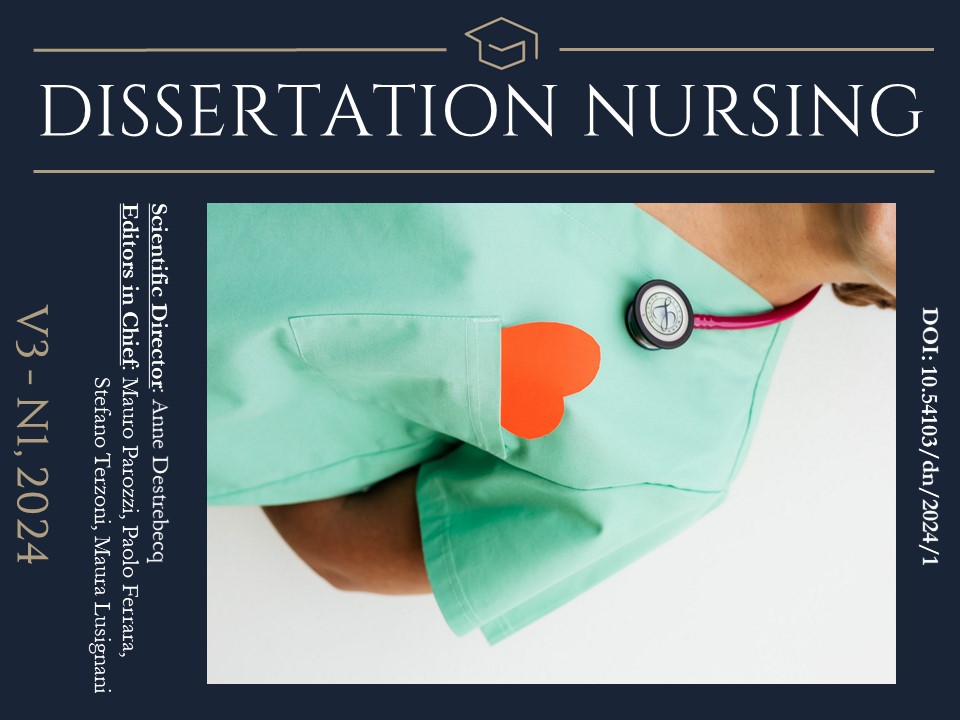Osteopathic treatment in the pediatric heart surgery patient: a retrospective observational study
DOI:
https://doi.org/10.54103/dn/21845Keywords:
osteopathic medicine, congenital heart defects, vital signs, pediatric nursing, NursesAbstract
BACKGROUND:
Osteopathy is a manual therapy modality which, through assessments of autonomic balance and manipulative treatments, is able to identify rigidities present in the body and remove them, in health and disease conditions.
AIM: To evaluate the effectiveness of osteopathic manipulative treatment, based on the improvements that occur in the patient undergoing invasive procedures in terms of changes in vital parameters, crying and feeding.
METHODS: A retrospective observational study was conducted, in which patients undergoing cardiac surgical, hemodynamic and arrhythmological procedures, aged between 0 and 18 years, were included. The data were collected through consultation of clinical and nursing documentation, for a total of 120 patients, divided into two groups: untreated group (N=67), subjected to no treatment; treated group (N=53), who received osteopathic care. The data were processed using the Excel program, SPSS version 24.0 and R© 3.6.3 software
RESULTS: The data analysis highlighted an absolute Pre-Post treatment variation in two of the vital parameters considered, such as the respiratory rate (absolute variation of -4.43) and the heart rate (absolute variation of -6.7), statistically significant in both cases (p ≤0.002).
CONCLUSION:
The study documents how osteopathic co-therapy is associated with a change in the conditions of the pediatric patient undergoing cardiac surgery in terms of respiratory and heart rate. Considering these results, osteopathy seems to be an effective support of conventional medicine in the care of children in the post-operative period.
References
Giarelli G, Roberti di Sarsina P, & Silvestri B. Le medicine non convenzionali in Italia. Franco Angeli; 2007.
Orem D, Renpenning K, & Taylor S. Self care theory in nursing. New York: Springer Publishing; 2003.
Lunghi C, Alò M, & Baroni F. Il ragionamento clinico osteopatico. Milano: Edra; 2017.
Cicchitti L, Di Lelio A, Barlafante G, Cozzolino V, Di Valerio S, Fusilli P, Lucisano G, Renzetti C, Verzella M, & Rossi MC. Osteopathic Manipulative Treatment in Neonatal Intensive Care Units. Medical sciences (Basel, Switzerland). 2020; 8(2), 24. https://doi.org/10.3390/medsci8020024
Johnson JD, Cocker K, & Chang E. Infantile Colic: Recognition and Treatment. American Family Physician. 2015; 92(7), 577–582.
Danielo Jouhier M, Boscher C, Roze JC, Cailleau N, Chaligne F, Legrand A, Flamant C, Muller JB & NEOSTEO Osteopath Study Group. Osteopathic manipulative treatment to improve exclusive breast feeding at 1 month. Archives of disease in childhood. Fetal and neonatal edition. 2021; 106(6), 591–595. https://doi.org/10.1136/archdischild-2020-319219
Gasperini M, Vanacore N, Massimi L, Consolo S, Haass C, Scapillati ME & Petracca M. Effects of osteopathic approach in infants with deformational plagiocephaly: an outcome research study. Minerva pediatrics. 2021;10.23736/S2724- 5276.21.06588-5. Advance online publication. https://doi.org/10.23736/S2724- 5276.21.06588-5
Ciranna-Raab C, Manzotti A, & Calzi P. La medicina osteopatica in pediatria. Milano: Edra; 2019.
Merkel, S. I., Voepel-Lewis, T., Shayevitz, J. R., & Malviya, S. (1997). The FLACC: A behavioral scale for scoring postoperative pain in young children. Pediatric Nursing, 23(3), 293–297.
Krebs EE, Carey TS, Weinberger M. Accuracy of the pain numeric rating scale as a screening test in primary care. J Gen Intern Med. 2007 Oct;22(10):1453-8. doi: 10.1007/s11606-007-0321-2. Epub 2007 Aug 1. PMID: 17668269; PMCID: PMC2305860.
Sposato NS, Bjerså K. Osteopathic Manipulative Treatment in Surgical Care: Short Review of Research Publications in Osteopathic Journals During the Period 1990 to 2017. J Evid Based Integr Med. 2018 Jan-Dec;23:2515690X18767671. doi: 10.1177/2515690X18767671. PMID: 29637792; PMCID: PMC5900809.
Racca V, Bordoni B, Castiglioni P, Modica M, Ferratini M. Osteopathic Manipulative Treatment Improves Heart Surgery Outcomes: A Randomized Controlled Trial. Ann Thorac Surg. 2017 Jul;104(1):145-152. doi: 10.1016/j.athoracsur.2016.09.110. Epub 2017 Jan 18. PMID: 28109570.
Bordoni B, Morabito B, Simonelli M, Nicoletti L, Rinaldi R, Tobbi F, Caiazzo P. Osteopathic approach with a patient undergoing cardiac transplantation: the five diaphragms. Int Med Case Rep J. 2019 Sep 5;12:303-308. doi: 10.2147/IMCRJ.S204829. PMID: 31564994; PMCID: PMC6733248.
Downloads
Published
How to Cite
Issue
Section
License
Copyright (c) 2024 Alessia Trani, Alessandro D'Antonio, Adriano Zenobi, Annalisa Cannarozzo, Valentina Felici, Monica Baldoni, Maurizio Mercuri, Chiara Gatti

This work is licensed under a Creative Commons Attribution-NonCommercial-NoDerivatives 4.0 International License.
Accepted 2024-01-09
Published 2024-01-31











